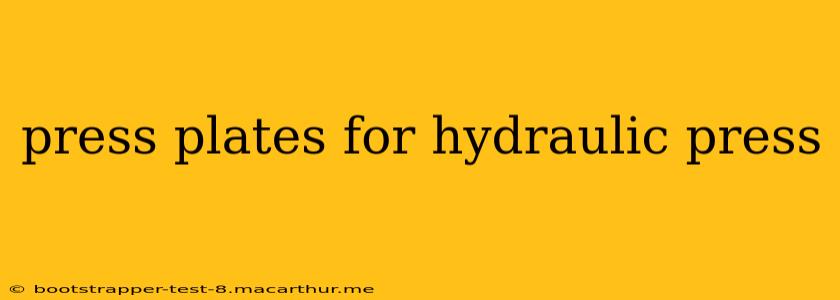Hydraulic presses are powerful machines used across diverse industries, from manufacturing and metalworking to automotive repair and recycling. A crucial component of any hydraulic press is the press plate, which directly interacts with the workpiece during the pressing process. Choosing the right press plate is essential for optimal performance, safety, and the longevity of the machine. This guide dives deep into the world of press plates, addressing common questions and providing valuable insights for selecting and maintaining these vital components.
What are Hydraulic Press Plates Made Of?
The material used for hydraulic press plates significantly impacts their durability, performance, and suitability for specific applications. Common materials include:
-
Steel: A widely used material due to its high strength, durability, and resistance to wear. Different grades of steel offer varying levels of hardness and impact resistance, making them suitable for a broad range of applications. High-carbon steel is often preferred for its exceptional strength and ability to withstand high pressures.
-
Cast Iron: Provides excellent compressive strength and wear resistance, making it a suitable choice for applications involving heavy loads and repetitive pressing. However, cast iron is more brittle than steel and susceptible to cracking under impact.
-
Tool Steel: For applications demanding exceptional hardness, wear resistance, and precision, tool steel press plates are often the preferred choice. These plates can maintain their shape and sharpness even under extremely high pressures. They are frequently used in specialized applications like stamping and forging.
-
Other Materials: Depending on the application and the material being pressed, other materials like hardened alloys or specialized composites might be employed. These choices are generally made to address specific challenges like corrosion resistance or extreme temperature conditions.
What are the Different Types of Hydraulic Press Plates?
Press plates come in various configurations, each designed for specific tasks:
-
Flat Plates: These are the most common type, suitable for general-purpose pressing applications. Their simple design makes them versatile and easy to use.
-
Shaped Plates: For specialized applications requiring specific contours or geometries, shaped press plates are necessary. These plates are custom-designed to match the workpiece's dimensions and shape.
-
Heated Plates: Used in applications requiring heat treatment or thermoplastic molding, heated plates are often equipped with integrated heating elements.
-
Cooled Plates: For applications where controlling heat is critical, cooled plates are used. These plates typically feature cooling channels to maintain a consistent, low temperature during the pressing operation.
How Do I Choose the Right Press Plate for My Hydraulic Press?
Selecting the appropriate press plate depends on several factors:
-
Press Capacity: The press plate must be capable of withstanding the maximum force generated by the hydraulic press without deformation or failure.
-
Workpiece Material and Properties: The material being pressed, its hardness, and its tendency to deform or fracture will determine the required press plate material and surface properties.
-
Application Type: Different applications require different plate designs. For example, deep drawing requires a different press plate than simple compression.
-
Plate Dimensions: The dimensions of the press plate must be compatible with the press itself and the workpiece size.
-
Budget: The cost of the press plate will vary depending on the material, size, and complexity of the design.
How Often Should I Replace My Hydraulic Press Plates?
The lifespan of a hydraulic press plate depends heavily on usage and the nature of the applications. Regular inspection for wear, cracks, or deformation is essential. Replacement should be considered when:
-
Significant wear or damage is visible: Scratches, gouges, or other signs of wear can compromise the press plate’s integrity and effectiveness.
-
The plate is deformed: Warping or bending can affect the uniformity of the pressing process and potentially damage the workpiece.
-
Cracks appear: Cracks can lead to catastrophic failure under pressure, posing a safety hazard.
-
Performance degrades: If the press consistently fails to achieve the desired results, the press plate might be the cause.
How to Maintain Hydraulic Press Plates?
Proper maintenance extends the lifespan of press plates:
-
Regular cleaning: Remove any debris or leftover material from the plate after each use.
-
Lubrication: For some applications, applying a suitable lubricant can reduce wear and friction.
-
Inspection: Conduct regular visual inspections to check for signs of wear or damage.
-
Storage: Store press plates in a clean, dry environment to prevent corrosion.
By carefully considering these factors and implementing proper maintenance, you can ensure your hydraulic press operates efficiently and safely, maximizing the lifespan of your press plates and minimizing downtime. Remember, consulting with a hydraulic press expert is always recommended for specialized applications or complex issues.
